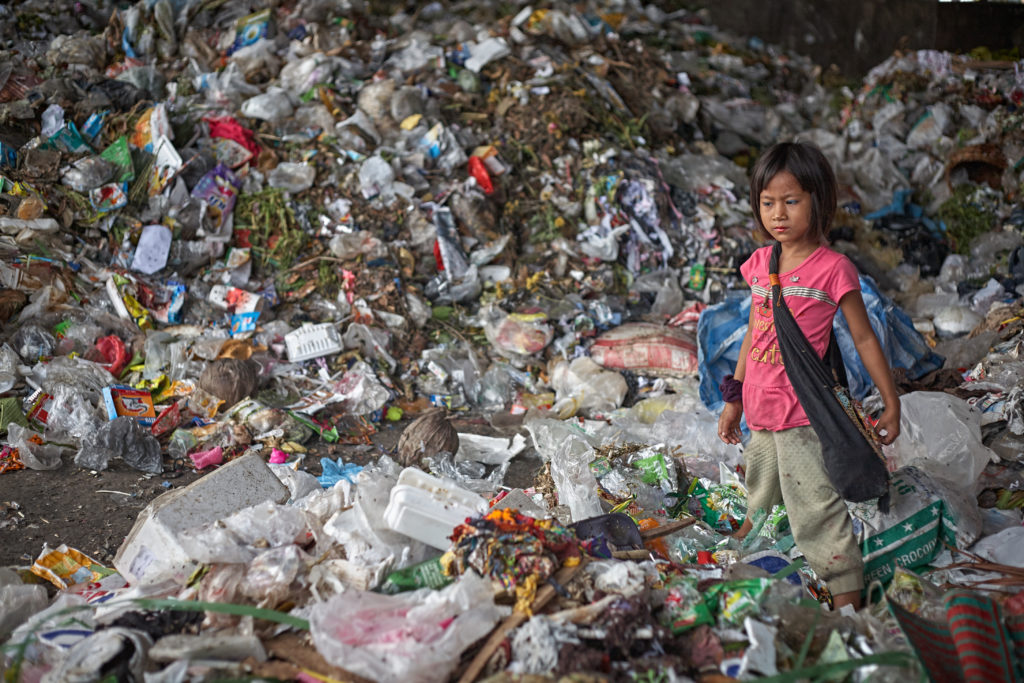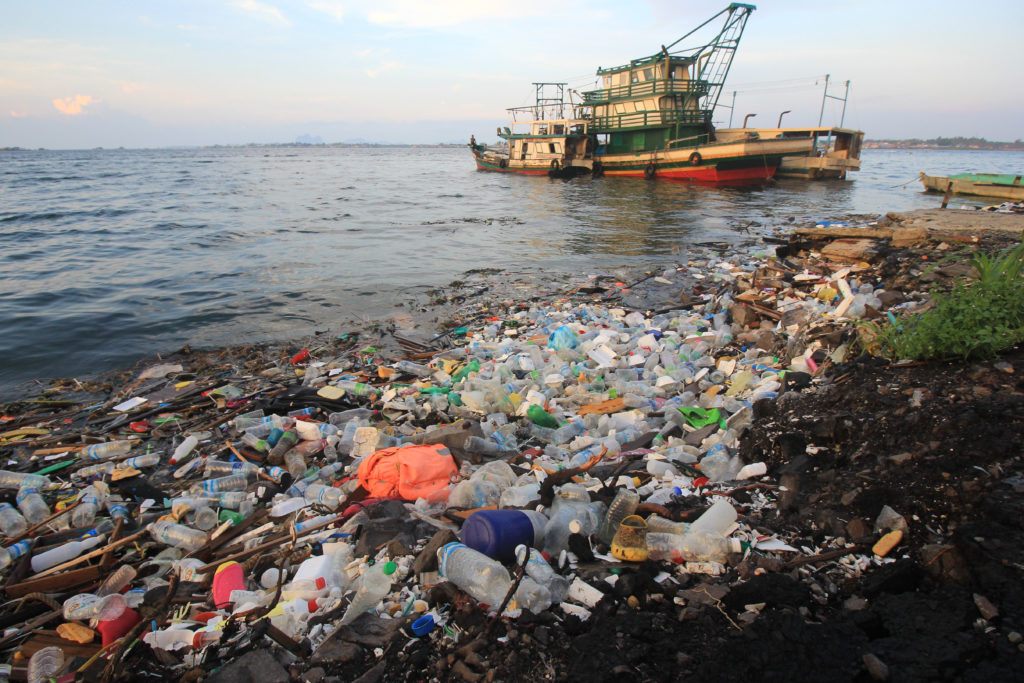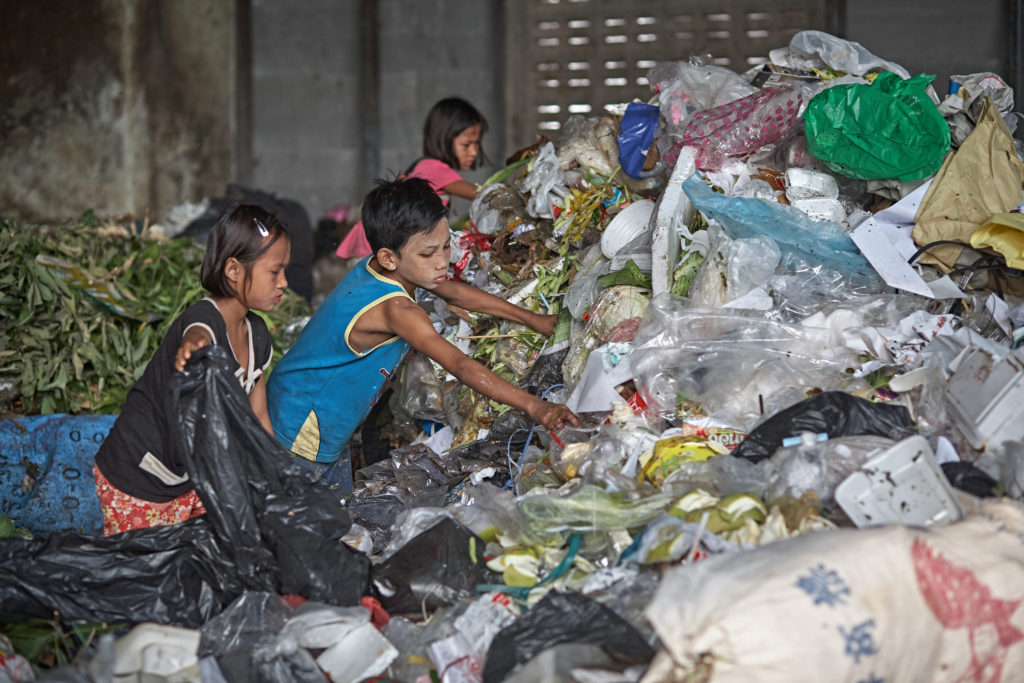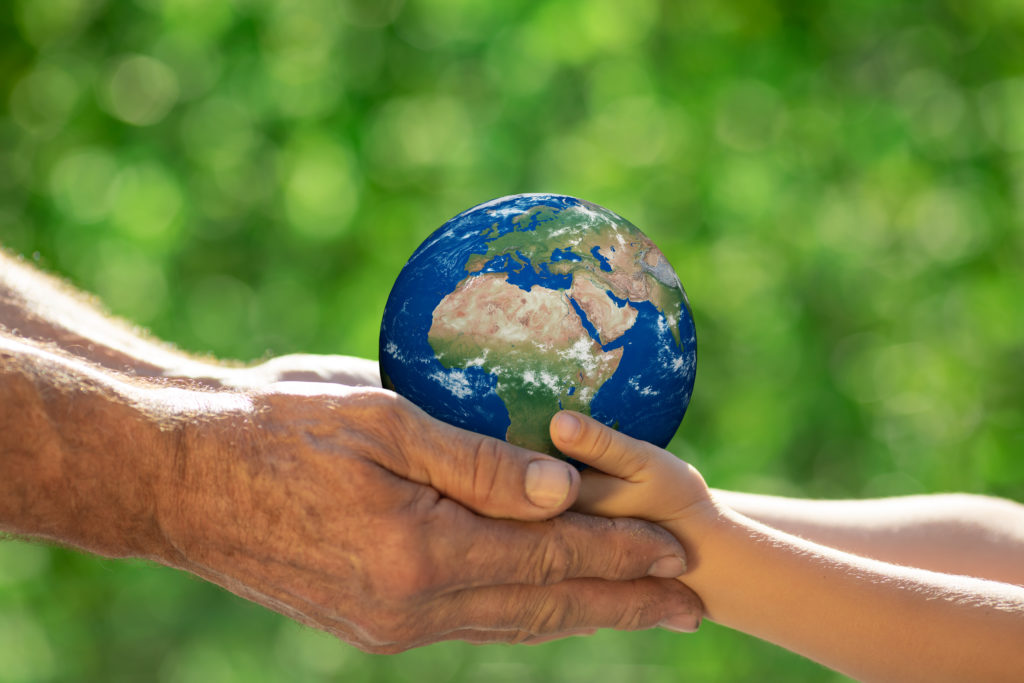No group is more vulnerable to environmental harm than children. Plastic production, use and disposal have a significant impact on children’s rights. Plastics contain toxic chemical additives, which can pose significant threats to children’s development. Therefore, even though by now it is clear that plastic has a detrimental impact on both the environment and children’s lives, what is left unsolved is how international treaties are to effectively address the plastic crisis, the further and long-term implications plastic pollution might have on children’s wellbeing, as well as the agreed solutions that can be utilised against plastic pollution.

What is plastic pollution?
Plastic is a pollutant that requires unique and heightened attention, as it breaks down very slowly and therefore accumulates in the environment. Some plastics are intrinsically toxic while others are toxic due to their additives. It carries toxic impacts throughout its lifecycle — from oil and gas drilling, to plastic refining and manufacture, to waste management including recycling, to plastic pollution that ends up in our oceans and environment (Centre for International Environmental Law, 2021).
The chemical bonds that make up plastic are strong and are made to last. The decomposition rate of plastic can vary depending on the type however; this typically ranges from 50 to 600 years (City of Westminster, 2022). Between 1950 and 2015, approximately sixty percent of all plastic ever produced (4,900 million tonnes) had been discarded and was accumulating in landfills or the natural environment. Today it is estimated that about 300 million tonnes of plastic waste is produced every year. To put things into perspective, that is the equivalent weight of the entire human population (United Nations Environment Programme, 2022).
Sixty percent of that plastic entered the environment (either via landfill or marine and terrestrial litter), twelve percent was incinerated, and only nine percent was recovered for recycling (Centre for International Environmental Law, 2019). False solutions to the plastic pollution crisis include waste incineration, chemical recycling, down-cycling and compostable bio-based plastic as well as landfilling.
Recycling often leads to significant chemical and microplastic pollution of water bodies when the wastewater is not adequately filtered and cleaned. Additionally, traded plastic waste contributes to direct plastic leakages in the ocean.
Mismanaged plastic as well as substances and chemicals from mismanaged and traded plastic waste are harmful to the environment and – either through leakage, residuals, burning, dumping or landfill – are found in our air, water and soils. Struggling to manage the ever-increasing amount of plastic waste, some cities and governments, influenced by a strong lobby of waste management corporations, are turning to waste incineration.
The environmental impact of plastics
The existing global plastics crisis is aggravating the planet and undermining the ability of future generations to enjoy their human rights in an environment that is conducive to leading life with dignity. Additionally, growing volumes of plastic waste impose debt on future generations (Alana Institute, 2022).

Coastal communities around the world are inundated with marine plastic litter. Scientific researches show how plastic in the ocean can impact the food chain, having negative health consequences due to pollutants introduced to the fish tissues by plastic ingestion (Forrest & Hindell, 2018). It is estimated that 5.25 trillion pieces of plastic debris weighing some 269,000 tonnes are present in the ocean (Azoulay, D., et al., 2019). There are also several links between plastics, climate change and the biodiversity crisis (Centre for International Environmental Law, 2019).
“Conventional fossil fuel-based plastics produced in 2015 accounted for 3.8 percent. If plastic production and use grow as currently projected, by 2030, plastic emissions could reach 1.34 gig tons per year equivalent to the emissions released by more than 295 new 500-megawatt coal-fired power plants.”
– Centre for International Environmental Law, 2019
Furthermore, according to the 2020 Global Biodiversity Outlook, “the rate at which plastic pollution enters aquatic ecosystems is projected to increase by 2.6 times the level of 2016 by 2040, under a ‘business as usual’ scenario. Even if current commitments to reduce plastic pollution were implemented in full, the reduction in pollution rates would only fall by 6.6 percent below” (Lau, Shiran, Bailey, & Cook, 2020).
The 2030 Agenda for Sustainable Development addresses the issue of plastic pollution as a top global priority. Sustainable Development Goal 14.1 states the need “[to] prevent and significantly reduce marine pollution of all kinds, in particular from land-based activities, including marine debris and nutrient pollution” by 2025 (The Office of the United Nations High Commissioner for Human Rights, 2022).
International instruments relevant to plastics
Currently, there exists no international legally binding instrument addressing the risks and harms to human health and the environment throughout all stages of the cycle of plastics. While the cycle is global, existing international instruments cover only certain marine regions or certain aspects of the plastic cycle (Wienrich, Weiand, & Unger, 2019). They offer fragmented responses that have proved inadequate in addressing the global plastic crisis (Japan Ministry of the Environment, 2020).
The International Convention for the Prevention of Pollution from Ships 1973 and 1978, and 1997 Protocols (International Maritime Organisation, 2022), (hereinafter the MARPOL Convention 1973 and 1978, 1997 Protocols) is the primary legal instrument that covers the prevention of marine pollution, including from plastics.
Furthermore, the UN Guiding Principles on Business and Human Rights 2011 is the framework that offers an opportunity for businesses to prevent and redress human rights abuses, including the elaboration of environmental assessments as a matter of course in their due diligence processes (The Office of the United Nations High Commissioner for Human Rights, 2022). The Sustainable Development Goals 2015 (hereinafter SDGs 2015) is an important tool to address the human rights dimensions of the plastics cycle (United Nations Department of Economic and Social Affairs, 2016). For instance goal 14, on conservation and sustainable use of the oceans, seas and marine resources, explicitly mentions plastics.
While each instrument contains certain provisions that concern plastic waste and certain plastic additives, they do not address the challenges of reducing the volumes of plastic production and waste, and controlling all hazardous additives (Lau, Shiran, Bailey, & Cook, 2020).
Children’s rights implications
“Plastic waste mainly flows from Global North to Global South countries. Most importing countries cannot always ensure this waste is managed in a manner that minimises harm to human health and the environment.”
– Basel Action Network (BAN) et al., 2021
Shipment to and mismanagement of plastic waste and its toxic burden exacerbates global inequalities. States have the obligation to protect children from harm, including preventable environmental causes that include “to protect the children’s rights to life, to health, to food, to water, to basically, to live in a safe environment, they have obligations concerning each of those children individually” (Basel Action Network (BAN) et al., 2021). The aforementioned ways of plastic waste management directly affect the enjoyment of children’s right to life, survival and development (article 6 of the Convention on the Rights of the Child (hereinafter CRC)).
The realisation of these rights is not possible without regard to the right to a healthy environment. States should thus take enhanced measures to respect, protect and enable children’s rights in relation to plastic (Hamilton, 2019).
The leaking of toxic substances and heavy metals as well as microplastic can directly affect the health of local communities living near places where the mismanagement (incineration and landfilling) happens, or indirectly through the contamination of crops, vegetables, fruits and meats as well as the water and air pollution. The smoke, pollutants and other particles emitted from the incineration and burning of plastic can trigger a wide range of health problems, particularly among children.
Due to children’s unique vulnerability, they are more susceptible than adults to the harmful effects of pollution. Cancer, endocrine disruption and adverse development are some of the major issues children face that are linked to chemicals used in plastic (Hamilton, 2019). Additionally, children are being born pre-polluted, which means that hazardous chemicals and pollutants are found in their bodies at birth.
Every year about 600.000 children under the age of five die as a result of air pollution and an additional 350.000 are directly caused by polluted water and they are exposed to these elements through their mother. This is the case during pregnancy and can also occur during menopause with biphenyl A, bringing an example of an element that adversely affects ovarian and uterine health (Maffini, 2006).
Another reoccurring issue in connection with plastic waste management in the form of landfilling is child labour. Low-income families from the neighbouring local communities search for means of survival in the landfills. Extreme poverty compels families to turn to child labour as one of the only options for survival.

This worst form of child labour not only violates the Worst Forms of Child Labour Convention, 1999 (International Labour Organisation, 2022) as well as Article 32 of the CRC but also violates the children’s right to education protected in Articles 28 and 32 of the CRC. The vulnerability of children is aggravated when they live in poverty, are exposed to dumping sites, or work as waste pickers (World Wide Fund for Nature and United Nations Major Group for Children and Youth, 2019).
With the presence of plastics, it is observed that this material plays an important and impactful role in children’s development. They grow up around piles of plastics, from toys to domestic waste and dumps as well as excessive advertising normalising the consumption of plastic products with no environmental criteria. The term “plasticised childhood” is coined to express this set of values and the impacts of the plastic lifecycle on a child’s development (Alana Institute, 2022).
Furthermore, the high level of greenhouse gas emissions occurring in the life cycle of plastic, particularly in the plastic waste management process, accelerates the process of the global climate crisis and increases the underlying risks of climate change to the enjoyment of children’s rights. The current greenhouse gas emissions from the plastic lifecycle threaten the ability to meet global climate targets and therefore violate the commitments made in the 2015 Paris Agreement.
What can be done?

The current international legal and policy framework governing plastics is fragmented and unsuited to confront the magnitude of the global threat of plastics. Growing volumes of plastic waste and exposure to toxic additives in plastics are aggravating environmental injustices. This dire situation requires strong policy responses at the global, regional and national levels (The Office of the United Nations High Commissioner for Human Rights, 2022).
Regional and national governments should additionally explore national legislative frameworks on Extended Producer Responsibility. These are emerging as innovative, low-cost solutions, as are policies to promote circular economies (International Union for Conservation of Nature (IUCN), 2021). An ambitious new framework is therefore needed to achieve the UN Sustainable Development Goals, and the vision of coexisting harmoniously with nature by 2050 (International Union for Conservation of Nature (IUCN), 2021).
Governments, research institutions and industries need to work collaboratively to redesign products and rethink their use and disposal to reduce microplastic waste from pellets, synthetic textiles and tyres. Consumers and society must shift to more sustainable consumption patterns. This will require solutions which go beyond waste management and consider the whole lifecycle of plastic products; from design to infrastructure, and household use (The Office of the United Nations High Commissioner for Human Rights, 2022).
A human rights-based approach is the key for governments to discharge their duty to prevent exposure and transition towards a circular economy in all stages of the plastic cycle. Informed participation of the public can ensure that plastic policy does not compromise the effective enjoyment of human rights for the sake of the profit expectation of certain business entities. Principles of prevention, precautionary and polluter-pays are critical to internalising costs and avoiding false solutions.
Accountability and the right to an effective remedy should guide the transformation of existing national and international legal and policy frameworks on plastics. It should also secure an effective remedy to those individuals and communities that have suffered harm. A reaffirmation of the right to a toxic-free environment is desperately needed (International Union for Conservation of Nature (IUCN), 2021).
There must be an end to the production and use of single-use, disposable plastic products. In the context of extraction-related emissions, emissions from plastic manufacturing and incineration or reducing the impacts of environmental plastic, the most direct and most effective way to address the plastic crisis is to drastically reduce the production of unnecessary plastic. Addressing plastic pollution at its source and stopping the production of non-essential plastic is the surest way to curtail emissions throughout the plastic lifecycle (Centre for International Environmental Law, 2019).
There must be a requirement for business enterprises to disclose the full chemical composition of plastic products including additives and to ensure that information on plastic composition and additives is publicly available. Additionally, business enterprises must actively work to eliminate the presence of toxic additives in plastic and the practice of recycling plastics containing hazardous substances; invest in closed-loop systems that do not generate hazardous emissions or waste (The Office of the United Nations High Commissioner for Human Rights, 2022).
In a broader sense, it is important to promote the human right to nature connection by acknowledging that children have the inherent right to connect with nature in a meaningful way, as a significant part of their everyday life and healthy development.
Written by Alexander Weihrauch and Igi Nderi
Last updated on 22 January 2023
Bibliography:
1989 Convention on the Rights of the Child. Retrieved from OHCHR at https://www.ohchr.org/documents/professionalinterest/crc.pdf, accessed on 8 January 2022.
Alana Institute. Children’s rights in regards to the lifecycle of plastics and human rights. Retrieved from OHCHR at https://www.ohchr.org/Documents/Issues/Environment/SREnvironment/ToxicWastes/CFI-lifecycle-plastics/Alana-institute.pdf, accessed on 11 January 2022.
Alice K. Forrest & Mark Hindell, Ingestion of plastic by fish destined for human consumption in remote South Pacific Islands. Retrieved from Australian Journal of Maritime & Ocean Affairs at https://ourworldindata.org/plastic-pollution accessed on 9 January 2022.
Azoulay, D., Villa, P., Arellano, Y., Gordon, M. F., Moon, D., Miller, K. A., & Thompson, K. Plastic & Health: The Hidden Costs Of A Plastic Planet. Retrieved from CIEL at https://static.sched.com/hosted_files/pacificunforumbhr/81/Plastic-and-Health-The-Hidden-Costs-of-a- Plastic-Planet-February-2019.pdf, accessed on 11 January 2022.
Basel Action Network (BAN), Centre for International Environmental Law (CIEL), European Environmental Bureau (EEB), Environmental Investigation Agency (EIA), Global Alliance for Incinerator Alternatives (GAIA), Naturschutzbund Deutschland (NABU), & Zero Waste Europe (ZWE). Irresponsibly Managed Plastic Waste Trade Has No Place In A Circular Economy (2021). Retrieved from The Plastic Waste Trade Manifesto at https://www.breakfreefromplastic.org/wp-content/uploads/2021/04/Waste-Trade-Manifesto-TEXTSIGN-1.pdf accessed on 11 January 2022.
Centre for International Environmental Law, “Plastic”. Retrieved from CIEL at https://www.ciel.org/issues/plastic/ accessed on 7 January 2022.
Centre for International Environmental Law,Plastic and Health – The Hidden Costs of a Plastic Planet. Retrieved from CIEL at https://www.ciel.org/wp-content/uploads/2019/02/Plastic-and-Health-The-Hidden-Costs-of-a-Plastic-Planet-February-2019.pdf accessed on 6 January 2022.
City of Westminster, Plastic Waste and Pollution. Retrieved from Clean Streets Westminster at https://cleanstreets.westminster.gov.uk/plastic-waste-complete-guide/accessed on 4 January 2022.
International Labour Organization, “C182- the Worst Forms of Child Labour Convention 1999. Retrieved from ILO at https://www.ilo.org/dyn/normlex/en/f?p=NORMLEXPUB:12100:0::NO::P12100_INSTRUMENT_ID:312327 accessed on 7 January 2022.
International Maritime Organisation. The International Convention for the Prevention of Pollution from Ships, 1973 (MARPOL). Retrieved from IMO at https://www.imo.org/en/KnowledgeCentre/ConferencesMeetings/Pages/Marpol.aspx accessed on 7 January 2022.
International Union for Conservation of Nature (IUCN). Marine plastic pollution. Retrieved from IUCN at https://www.iucn.org/resources/issues-briefs/marine-plastic-pollution accessed on 8 January 2022.
International Union for Conservation of Nature (IUCN). Post-2020 global biodiversity framework. Retrieved from IUCN at https://www.iucn.org/resources/issues-briefs/post-2020-global-biodiversity-framework accessed on 8 January 2022.
Japan Ministry of the Environment. G20 Report on Actions against Marine Plastic Litter: Second Information Sharing Based on the G20 Implementation Framework-2020 (2020). Retrieved from G20 Report on Actions against Marine Plastic Litter at https://g20mpl.org/wp-content/uploads/2021/07/G20MPL-report-2021_final-edition1119.pd accessed on 7 January 2022.
Lisa Anne Hamilton and others. Plastics and Climate: The Hidden Cost of a Plastic Planet. Retrieved from the Centre for International Environmental Law at https://greenwire.greenpeace.de/system/files/2019-05/20190515-report-plastic-and-climate-ciel.pdf accessed on 9 January 2022.
Marricel V. Maffini and others. “Endocrine disruptors and reproductive health: the case of bisphenol-A”,Molecular and Cellular Endocrinology. Retrieved from PubMed at doi: 10.1016/j.mce.2006.04.033 accessed on 9 January 2022.
Nicole Wienrich, Laura Weiand and Sebastian Unger, Stronger Together: The Role of Regional Instruments in Strengthening Global Governance of Marine Plastic Pollution. Retrieved from Institute for Advanced Sustainability Studies at https://publications.rifs-potsdam.de/rest/items/item_6000714_10/component/file_6000763/content accessed on 7 January 2022.
Lau, W. W. Y., Shiran, Y., Bailey, R. M., Cook, E., et al. “Evaluating scenarios toward zero plastic pollution”.Retrieved from The Global Biodiversity Outlook at https://doi.org/10.1126/science.aba947 accessed on 6 January 2022.
Office of the High Commissioner for Human Rights, Convention on the Rights of the Child, 1989. Retrieved from OHCHR at https://www.ohchr.org/documents/professionalinterest/crc.pdf accessed on 4 January 2022.
The Office of the United Nations High Commissioner for Human Rights, Call for submission, “the lifecycle of plastics and human rights”. Mandate of the Special Rapporteur on toxics and human rights. Retrieved from OHCHR at https://www.ohchr.org/EN/Issues/Environment/SRToxicsandhumanrights/Pages/lifecylce-plastics.aspx accessed on 6 January 2022.
United Nations Department of Economic and Social Affairs, The 17 Sustainable Development Goals. Retrieved from UNSDGs at https://sdgs.un.org/goals accessed on 7 January 2022.
United Nations Environment Programme, Beat Plastic Pollution. Retrieved from Our planet is choking on plastic at https://www.unep.org/interactive/beat-plastic-pollution/ accessed on 4 January 2022.
United Nations Environment Programme, Basel Convention on the Control of Transboundary Movements of Hazardous Wastes and their Disposals, 1989. Retrieved from UNEP at https://www.basel.int/Portals/4/Basel%20Convention/docs/text/BaselConventionText-e.pdf accessed on 7 January 2022.
United Nations Environment Programme, the Stockholm Convention on Persistent Organic Pollutants 2001. Retrieved from UNEP at http://chm.pops.int/Portals/0/Repository/convention_text/UNEP-POPS-COP-CONVTEXT-FULL.English.PDF accessed on 7 January 2022.
World Wide Fund for Nature and United Nations Major Group for Children and Youth. Solving Plastic Pollution through Accountability. Retrieved from WWF at https://www.worldwildlife.org/publications/solving-plastic-pollution-through-accountability accessed on 9 January 2022.

